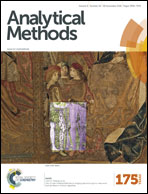Development of a dispersive liquid–liquid microextraction technique for the analysis of citrinin, alternariol and alternariol monomethyl ether in fruit juices
Abstract
A new method based on dispersive liquid–liquid microextraction (DLLME) combined with high-performance liquid chromatography with fluorescence detection has been established to detect citrinin, alternariol and alternariol monomethyl ether in fruit juices. The effective parameters in the DLLME process, including sodium chloride percentage, pH, and volumes of extraction and dispersive solvents, were optimized using the response surface methodology based on a central composite design. Under the optimum conditions, mean recoveries of the three mycotoxins from fruit juices were in the range of 80.1–93.4% with relative standard deviations lower than 5.7%. The detection limits were in the range of 0.022–0.203 ng mL−1. A comparison of this method with previous methods demonstrated that the proposed method is an accurate, rapid and reliable sample-pretreatment method that gives very good enrichment factors and detection limits for extracting and determining citrinin, alternariol and alternariol monomethyl ether in fruit juices.


 Please wait while we load your content...
Please wait while we load your content...